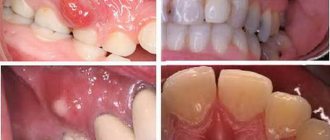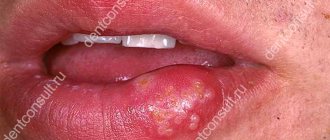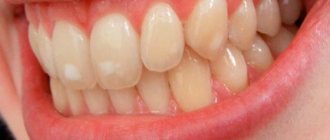Types of flux
This pathology is characterized by several stages of its clinical development. At the first stage, minor pain appears. The second stage is characterized by swelling and redness of the gums in the area of infection.
During the third stage, pus appears, the temperature rises, and the cheek and gum area swell noticeably. At the fourth stage, a person feels a sharp throbbing pain, swelling intensifies, and an extensive inflammatory process may begin. The following types of flux exist:
- Ordinary.
The pathological process occurs without infiltration of the periosteum by pus;
- Fibrous.
With this type of periostitis, inflammation spreads to the periosteum tissue;
- Orthodogenic periostitis.
The disease manifests itself in the form of osteomyelitis, which is a serious complication requiring surgical tooth extraction;
- Albuminous flux.
Chronic pathology, which is characterized by a sluggish course, subfertile temperature and suppuration.
Only a dentist can determine the type of disease and prescribe proper treatment, but before visiting, it is necessary to stop the process.
Why is periostitis dangerous and how to avoid it?
The causes of the disease do not appear overnight, but accumulate in the body over several months or years. Therefore, it is very simple to resist the appearance of tooth flux in an adult:
- Get a routine dental checkup every 6 months. This way you can identify pathologies and anomalies of the oral cavity in the bud and, using simple procedures, prevent their transformation into gumboil.
- Use professional oral hygiene services once every six months. Tartar and hard plaque cannot be removed at home, but they become the cause of many oral diseases.
- Consume more vegetables and fruits. They supply the body with useful substances, and also perform mechanical cleaning of the teeth and interdental spaces during the chewing process.
Possible complications of periostitis in the absence of treatment: sepsis, meningitis, abscess, phlegmon, osteomyelitis and others, up to and including admission to the department of maxillofacial surgery.
Any disease, including gum gum disease, is easier to prevent than to treat. If the inflammatory process has begun, do not rely on traditional methods and self-treatment. The purulent formation will not disappear on its own; only high-quality medical intervention will help eliminate the inflammation and avoid serious consequences.
Rinse with flux
Rinse solutions have a regenerating and anti-inflammatory effect on the pathological focus. You can use a soda solution, which reduces pain and inflammation. Rinsing should be done every two hours. Two teaspoons of soda are dissolved in 200 ml of warm water and used throughout the day.
Manganese solution has good therapeutic efficacy. It will reduce swelling by eliminating pathogenic microorganisms. You can use the drug Rotokan, which includes chamomile, yarrow and calendula. To prepare the solution, just add one spoon of Rotokan to warm water. You should rinse your mouth at least 4-5 times a day.
Antiseptics such as Chlorhexedine and Miramistin are also used. They do not need to be dissolved in water. It is enough to irrigate the affected cavity in order to reduce swelling, pain and inflammation. Rinse products similar in their therapeutic effects to Miramistin and Chlorhexidine also include Furacilin, which is sold in tablets. A couple of tablets are enough to prepare 200 ml of solution for treating the oral cavity.
How to cure gumboil
With periostitis, there can be no talk of any home treatment. Prompt medical attention is required. At best, home treatments will briefly relieve symptoms; at worst, they will accelerate the course of inflammation. It is strictly forbidden to heat the affected area (as the pus spreads faster), take antibiotics and painkillers without a doctor’s prescription (there is a risk of bleeding). If you ignore the problem, you can achieve sepsis - blood poisoning - and even death.
At the clinic, the doctor conducts an examination, consultation, and, if necessary, prescribes x-rays and blood tests to determine the extent of the disease and the level of leukocytes. If the patient seeks help at an early stage of periostitis, the specialist prescribes therapeutic treatment. This is taking antibiotics and anti-inflammatory drugs that destroy pathogens. If the situation is advanced, the doctor removes the flux through surgery: administers anesthesia, makes an incision in the gum, cleans out the pus, disinfects the wound and installs drainage. Additionally, laser therapy or iontophoresis may be needed.
This is followed by a period of rehabilitation: taking antibiotics, immunomodulators, rinsing with antiseptics. Monitor the condition of the oral cavity for 3-4 days. If during this time the symptoms do not subside and the swelling does not go away, you should consult a doctor again. If the tooth crown is destroyed by more than 50%, as well as in case of relapse of periostitis, the tooth will have to be removed.
Compresses and lotions for periostitis
Compresses and lotions have a local anti-inflammatory and disinfecting effect, they destroy pathogenic microbes and will help get rid of swelling on the mucous membrane. You can use the drug Dimexide, which is diluted with water until a concentration of 20-30% is reached. The compress is applied to the area of inflammation and left for about an hour.
Soda lotions also help a lot. Baking soda is diluted in a volume of two teaspoons in 200 ml of water. You can moisten a cotton pad or several layers of gauze with the solution and then apply the lotion to the affected area of the gum.
Good therapeutic effectiveness is also observed when using salt compresses. It is enough to dissolve a couple of teaspoons in 100 ml of warm water. A gauze swab soaked in the solution should be applied to the inflamed area and held between the gum and cheek for at least half an hour.
Treatment of flux and removal of edema
Dental flux (odontogenic periostitis) is a purulent disease in the subgingival and subosseous jaw area. It occurs as a result of inflammation of the tooth root and manifests itself in the form of a purulent sac on the gum. If you do not consult a dentist in time with this diagnosis, then there is a very high probability that the tooth will have to be removed and dental implantation performed or dental prosthetics performed in another way. And this is not the worst option, because the infection can enter the circulatory system and then the whole body is in danger!
Causes of flux
The causes of the disease are varied. It can be a consequence of an advanced stage of caries and its complications, a tooth bruise, or an inflamed pocket between the tooth and the gum. It can also appear as a result of infection, when food debris that accumulates in the tooth cavity begins to rot. Pus makes channels in the bone tissue and looks for a way out. It is stopped by the periosteum or lower jaw. The inflammatory process is accompanied by pathological changes in tissue, a person’s temperature rises and severe toothache (often unbearable) is observed.
Flux treatment
Treatment tactics depend on the localization of the process, the location of the tooth, and the form of inflammation. At an early stage, swelling is relieved with the help of antibiotics and high-quality painkillers. But first, the specialist must assess the condition of the tooth root, after which he will decide on the advisability of removing or preserving it. Please note that specialists at our dental clinic in Perm make a decision to remove a tooth only in exceptional cases when the inflammatory process poses a threat of blood poisoning. The purulent form is treated with surgery. The dentist will remove the abscess and carry out a series of antiseptic actions in the area of inflammation. All manipulations are carried out under the influence of painkillers. The dentist will make a small incision near the diseased tooth through which the pus will be released. In some cases, to ensure complete outflow, drainage in the form of a rubber strip is left in the incision. This manipulation in combination with anti-inflammatory and antibacterial agents quickly relieves swelling.
For patients from other regions, our clinic offers such a popular service as dental tourism. You can undergo complex treatment, prosthetics, dental implantation and other procedures and still have a good rest! We provide: preferential accommodation and assistance in organizing leisure activities. To preliminary draw up a treatment plan remotely and estimate the cost, contact us in any way convenient for you: by email, by phone or via a widget (send a request or request a free call back).
How to relieve swelling at home?
If you have gumboil, only a dentist can remove the swelling. Especially if it is manifested by an increase in body temperature. If you are unable to see a doctor immediately, you can try rinsing with sage or green tea infusion (but this should only be done in exceptional cases). All folk remedies have a weak effect and practically do not relieve pain. In addition, they will not eliminate the cause of the flux. These are just temporary measures that can help disinfect your mouth. Rinsing will in no way cure periostitis, but will only slightly slow down the process, which will reduce the risk of unfortunate consequences while the patient is unable to get an appointment with the dentist. If you are within reach of a doctor, then treating periostitis at home is strictly prohibited, as this can lead to disastrous consequences. You should immediately contact a dental clinic at any time of the day or night. If pus is not removed in a timely manner, inflammation can quickly spread to adjacent tissues. The Kostamed dental clinic operates around the clock, so you can contact us at any time. The dentist on duty will diagnose the flux and relieve the swelling.
Folk remedies
For treatment, traditional medicine offers different recipes. Below are some of them:
- Alcohol tincture of calendula (1 tsp per glass of water).
- Hot infusion of Siberian or red elderberry (a handful of berries in three cups of boiling water, cook for 15 minutes, leave for 2 hours).
- Heat flaxseed, 3 tbsp. wrap in cotton cloth, then tie with thread and apply to the cheek.
- Brew a mixture of green tea and sage and add half a teaspoon of salt. Rinse your mouth with hot infusion.
- 4 tbsp. l. pour lemon balm leaves with two glasses of boiling water. After 4 hours, express and rinse.
There are also quite ridiculous recipes for “treatment”:
- Make “cigarettes” from the cat’s paw plant, smoke without inhaling the smoke into your lungs.
- Place a piece of salt-free lard between the gum and cheek and hold for 30 minutes.
- Chop the garlic and apply it to your wrist.
- Mix tar with sea buckthorn in equal proportions and apply as a compress.
- Burdock, radish and sorrel in the form of a compress.
Doctors at the Kostamed dental clinic will provide:
- maintaining the integrity and health of the oral cavity;
- prevention of dental diseases;
- creating a perfect smile;
- preventing serious complications;
- minimizing life-threatening risks;
- high aesthetics and beauty, and, consequently, higher success in career and personal life.
If you have the slightest symptoms of dental flux, then call us 24/7 as soon as possible and come to Costamed dentistry. We will definitely help you!
Anti-inflammatory drugs and antibiotics
The use of antibiotics helps relieve pain and stop acute inflammation. You can use antibiotics such as Trichopolum, Lincomycin, Ciprofloxacin, Flemoxin, Biseptol, Amoxiclav, Tsiprolet. Antibacterial drugs should not be used for more than five days to avoid microbial resistance in the body.
To reduce swelling and redness, you can additionally take Diazolin, Nimesil or Diclofenac, which have a local anti-inflammatory and decongestant effect.
Gels and ointments
Ointments are used for topical application. In particular, this is Vishnevsky’s ointment, which stops the development of the purulent process. The birch tar included in its composition increases blood circulation in tissues and accelerates their natural regeneration.
Among modern gels, it is recommended to use the drug Metrogyl Denta, which contains antibacterial components in the form of Chlorhexidine and Metronidazole.
This article is for informational purposes only, please consult your doctor for details! Ask your doctor about contraindications and side effects.











